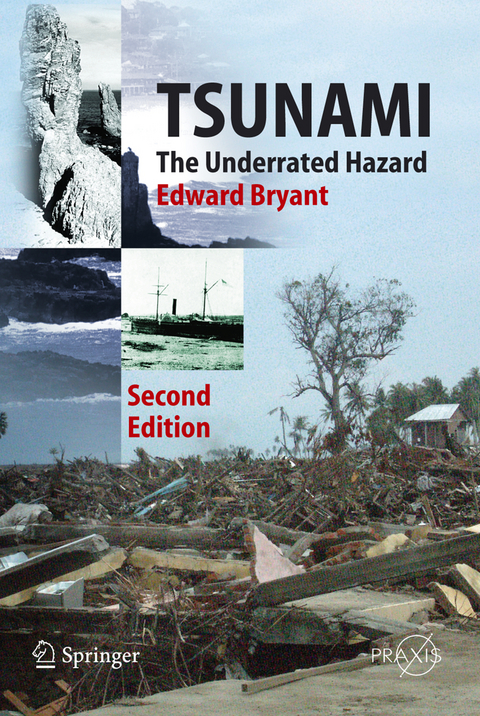
Tsunami
Springer Berlin (Verlag)
978-3-642-09361-6 (ISBN)
In the last three years, there have been three large tsunamis in the Indian Ocean, most notably the notorious one which struck on 26 December 2004 and killed more than 238,000 people. It was generated by one of the largest recorded earthquakes in the last 100 years. Such events occur about four times per century, mainly in the Pacific Ocean. Few scientists were aware that the Indian Ocean was vulnerable: only Thailand had been warned of the potential for such an event. However, tsunami are also insidious local hazards. Since 1990, at least eleven events have impacted on the world's coastlines, causing devastation and loss of life. Tsunami are underrated as major hazards, mainly due to the misconceptions that they occur infrequently compared to other natural disasters and happen along some distant shoreline, most likely in a developing country. Evidence for past great tsunami, or "mega-tsunami" has also recently been discovered along apparently aseismic and protected coastlines, such as those of Australia and Western Europe. These mega-tsunami are caused by either huge submarine landslides or the impact of meteorites and comets with the ocean. With a large proportion of the world's population living on the coastline, the threat from tsunami cannot be ignored.
Dr Edward Bryant is a renowned and respected tsunami researcher, writer and teacher in the areas of natural hazards and climatology. Tsunami: The Underrated Hazard was first published by Cambridge University Press in 2001. This is now out of print and CUP confirmed that all rights in the book have reverted to the author. The 2nd Edition incorporates the great Indian Ocean tsunami in 2004 and the author focuses on geomorphology and the processes and events linked to the main causes of tsunami, namely, earthquakes, volcanoes, landslides and, in addition, comet and meteorite impacts.
Tsunami as a known hazard.- Tsunami dynamics.- Tsunami-formed landscapes.- Signatures of tsunami in the coastal landscape.- Coastal landscape evolution.- Causes of tsunami.- Earthquake-generated tsunami.- Great landslides.- Volcanic eruptions.- Comets and asteroids.- Modern risk of tsunami.- Risk and avoidance.- Epilogue.
From the reviews of the second edition:
"A much needed, up-to-date introductory work on tsunamis with worldwide coverage. ... Many high-quality maps, figures, charts, and exceptional photographs augment the text; an extensive list of cited references is especially valuable. This book will have noteworthy appeal to students and professionals alike in the fields of geomorphology, coastal engineering, environmental sciences, and economics. It will also be valuable to geographers, civic and emergency planners, and the general public living along coastlines the world over ... . Summing Up: Recommended. All readers/libraries." (T. L. T. Grose, CHOICE, Vol. 46 (01), September, 2008)
"The main focus of the book was and remains the formation of landscape features by large tsunami. ... The greatest value of this book may well be to raise awareness in the public and among policy makers ... . the book very accessible to the general public and those who have limited scientific aptitude. ... The book concludes with a discussion of modern tsunami risks and warning systems, followed by an epilogue which presents several plausible scenarios of future tsunami disasters." (Michael Antolik, Pure and Applied Geophysics, Vol. 166, 2009)
From the reviews of the second edition:"A much needed, up-to-date introductory work on tsunamis with worldwide coverage. … Many high-quality maps, figures, charts, and exceptional photographs augment the text; an extensive list of cited references is especially valuable. This book will have noteworthy appeal to students and professionals alike in the fields of geomorphology, coastal engineering, environmental sciences, and economics. It will also be valuable to geographers, civic and emergency planners, and the general public living along coastlines the world over … . Summing Up: Recommended. All readers/libraries." (T. L. T. Grose, CHOICE, Vol. 46 (01), September, 2008)“The main focus of the book was and remains the formation of landscape features by large tsunami. … The greatest value of this book may well be to raise awareness in the public and among policy makers … . the book very accessible to the general public and those who have limited scientific aptitude. … The book concludes with a discussion of modern tsunami risks and warning systems, followed by an epilogue which presents several plausible scenarios of future tsunami disasters.” (Michael Antolik, Pure and Applied Geophysics, Vol. 166, 2009)
| Erscheint lt. Verlag | 30.11.2010 |
|---|---|
| Reihe/Serie | Geophysical Sciences | Springer Praxis Books |
| Zusatzinfo | XXXIV, 330 p. 58 illus., 6 illus. in color. |
| Verlagsort | Berlin |
| Sprache | englisch |
| Maße | 170 x 242 mm |
| Gewicht | 634 g |
| Themenwelt | Naturwissenschaften ► Biologie ► Ökologie / Naturschutz |
| Naturwissenschaften ► Geowissenschaften ► Geografie / Kartografie | |
| Naturwissenschaften ► Geowissenschaften ► Geologie | |
| Naturwissenschaften ► Geowissenschaften ► Geophysik | |
| Naturwissenschaften ► Geowissenschaften ► Hydrologie / Ozeanografie | |
| Schlagworte | coast • Coastal attrition • Earthquake • Hazard • Indian Ocean • Marine • natural disaster • ocean • Oceanography • Pacific Ocean • Tsunami |
| ISBN-10 | 3-642-09361-2 / 3642093612 |
| ISBN-13 | 978-3-642-09361-6 / 9783642093616 |
| Zustand | Neuware |
| Haben Sie eine Frage zum Produkt? |
aus dem Bereich


